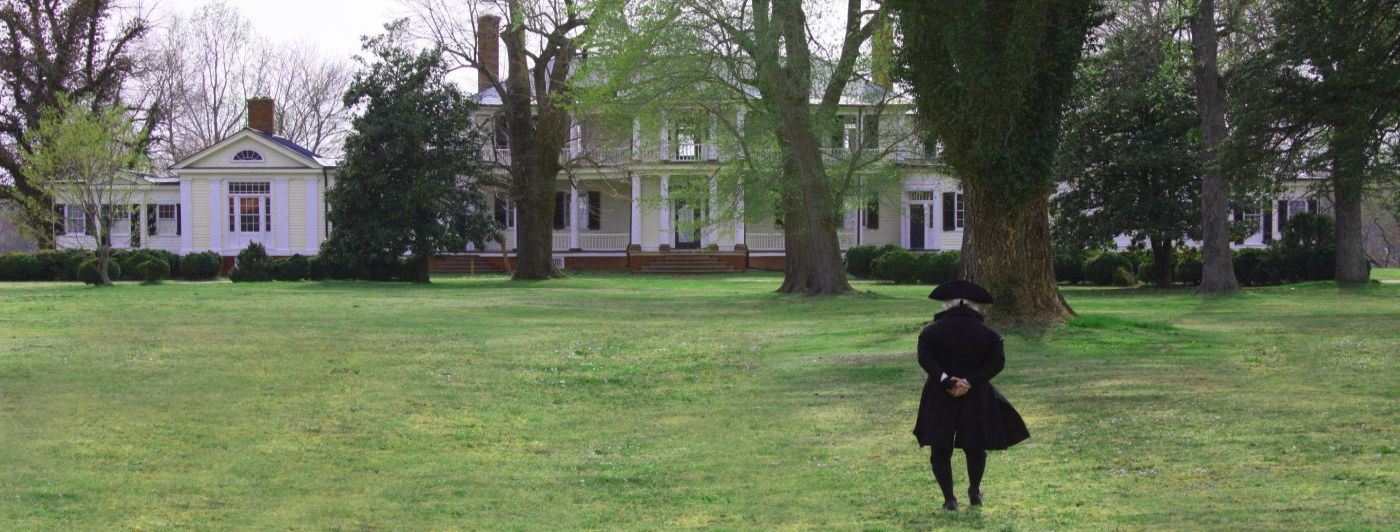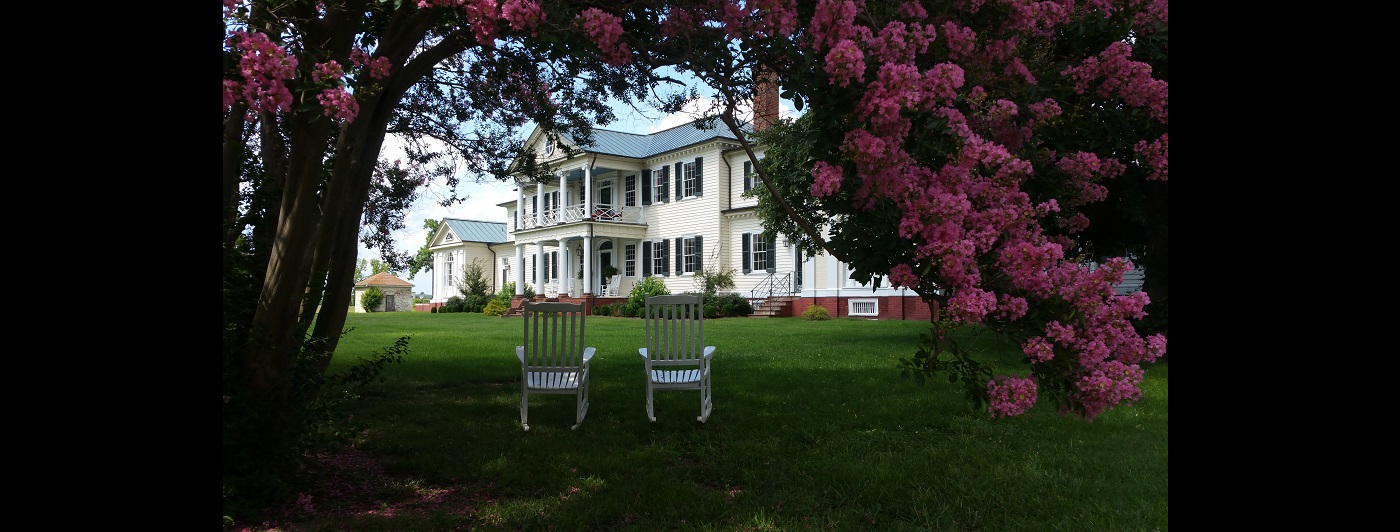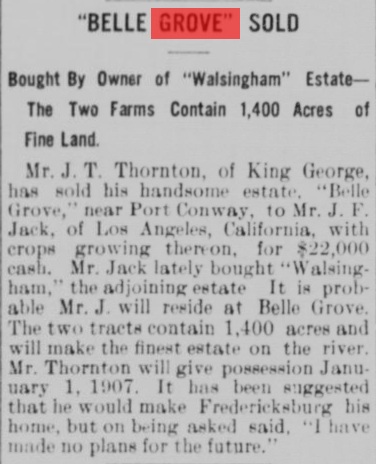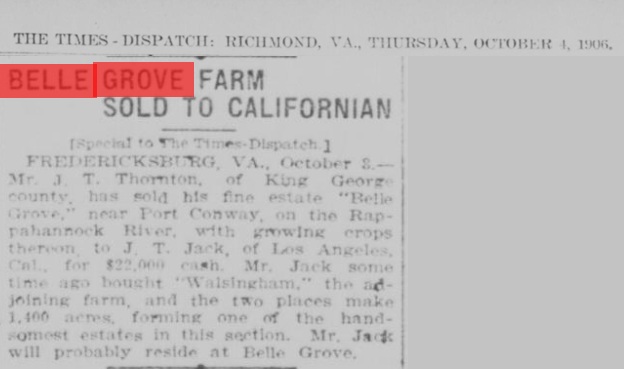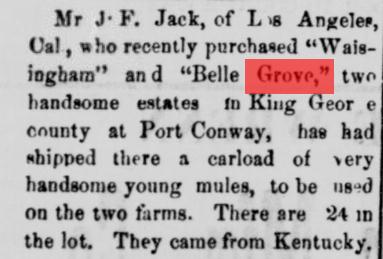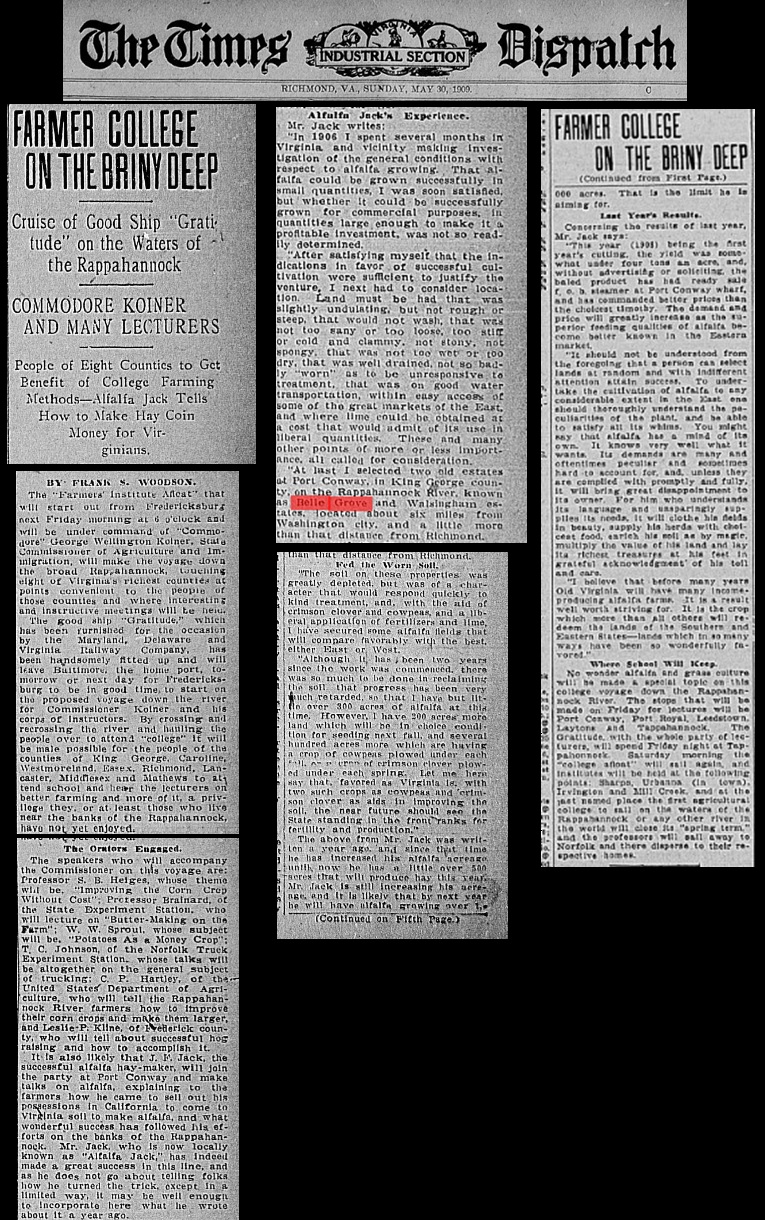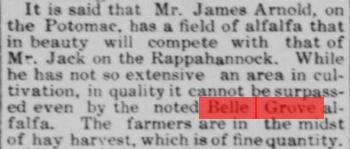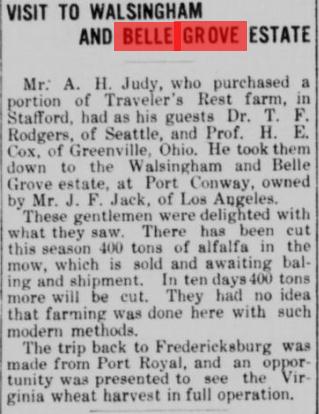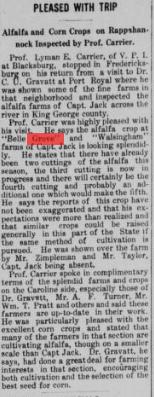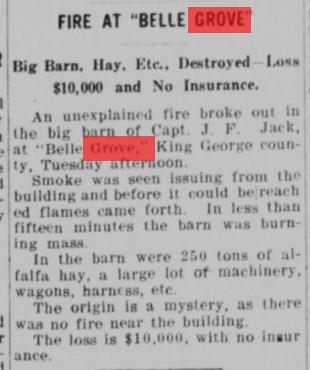Captain Jack
I thought it would be good to get back to the history of Belle Grove and continue this journey. When we last spoke, it was 1906. In an article from the Free Lance Star of Fredericksburg dated October 4, 1906, we learn that the Thornton Family’s time at Belle Grove has come to an end. John Thornton would sell Belle Grove to Captain J.F. Jack of Los Angeles, California. Captain Jack already owns Walsingham, the plantation just next door. In the time of the Turners, Walsingham was owned by George Turner while Carolinus Turner owned Belle Grove. George was Carolinus’s cousin. By combining the two plantations, there would be 1,400 acres of farm land.
Captain Jack will not take Belle Grove until January, 1907. He would live at Belle Grove in the mansion. Walsingham had lost its beautiful home years before.
In the second article from The Times-Dispatch of Richmond dated October 4, 1906 we find out that Captain Jack purchased Belle Grove for $22,000. Not a bad profit for John Thornton of $13,000.
But who was this Californian that purchased these two beautiful plantations? This has been a question for us for a long time. In all the research I have done on the plantation, this is one of the owners whose past has been hard to uncover. Believe it or not, I found more on the Colonial Period of this plantation than I have with the owners of the early 1900s.
From what I have uncovered, Captain Jack was an experimental farmer from California. He arrived in Virginia in the early 1900s with the goal to find out if alfalfa would grow in Virginia. As far as the personal side of Captain Jack, the only information I have is that he was from Los Angeles, California. Once again I had to turn to newspapers to build something of a history of him.
The first time we found Captain Jack in the newspaper was in February 1907. He would have owned Belle Grove for about four months at this point. In this article, it reports that Captain Jack has shipped a “carload of very handsome young mules”. It even gives us how many are in a “carload”. There were 24 total and they came from Kentucky.
The next article gives us more insight into why Captain Jack moved to Virginia. We know he was an experimental farmer, but from reading this article, it seems that he was also here to teach. In the summer months of 1909, The Farmers Institute put on a cruise down the Rappahannock River with the goal to give local farmers the opportunity to hear about new and more modern methods of farming. This cruise which started in Fredericksburg was headed by “Commodore” George Wellington Koiner, Commissioner of Agriculture and Immigration and several instructors. Touring on the good ship “Gratitude” they would touch eight counties and their farmers along the Rappahannock River.
One of the speakers was Captain Jack of Belle Grove. They speak of how Captain Jack of Port Conway was a successful alfalfa hay-maker. He was to “explain to the farmers how he came to sell out his possessions in California to come to Virginia soil to make alfalfa and what wonderful success has followed his efforts.” Known locally as “Alfalfa Jack”, he would tell how he came to Virginia in 1906 and spent several months traveling the area and observing “the general conditions with the respect to alfalfa growing.” He had observed that alfalfa could be grown in small quantities, but what he wanted to know is if it could be produced for commercial purposes and in large enough quantities to make it profitable.
Once he had determined that the area was sufficient to justify the venture, he set forth to find the right place to do it. The land he was looking for “must be slightly undulating, but not rough or steep, that would not wash, that was not too sandy or too loose, too stiff or cold and clammy, not too stony, not too spongy, that was not too wet or too dry, that was well drained, not so badly “worn” as to be unresponsive to treatment, that was on good water transportation, within easy access of some of the great markets of the East and where lime could be obtained at a cost that would admit of its use in liberal quantities’.” Whew… He wasn’t too picky was he?
He would find this land in the two plantation estates of Belle Grove and Walsingham. He states that the soils of these plantations were greatly depleted, but he felt that they had a character that would respond quickly to treatment. With the aid of crimson clover and cowpeas and a liberal application of fertilizer and lime, he felt that he could create alfalfa fields that would compare to the best in the East or West.
After two years, however, he found that the soil was more depleted that thought and it was taking a lot longer to ready the soil. At this point Captain Jack had only 300 acres of alfalfa, but was expecting to plant 200 acres more next fall. Plus he had several hundred more filled with crimson clover and cowpeas ready to be plowed under for future fields. Captain Jack felt that with crimson clover and cowpeas as aids, if used throughout Virginia, the state would soon stand “in the front ranks for fertility and production.”
It states that Captain Jack was still working on adding to his acreage and that by one year he was expected to have over 1,000 acres. He stated that the coming year of 1908, he was expecting to yield just under 4 tons an acre and without advertising or marketing and through shipment by steamer from the Port Conway wharf, he felt that the price would be better than most. He also saw that in the coming years the demand and price would increase as the product became better known in the East.
He explained though that before undertaking this crop, one had to know the plant and everything that it needed. He states that alfalfa has a “mind of its own” and it knows what it wants and needs. And if a farmer took on this crop without the right knowledge, he would lose his investment.
Captain Jack summoned up his thoughts:
“For him who understands its language and unsparingly supplied it needs, it will clothe his fields in beauty, supply his herds with food, enrich his soil, multiply the value of his land and lay its richest treasure at his feet in grateful acknowledgment of his toll and care. I believe that before many years Old Virginia will have many income producing alfalfa farms. It is a result well worth striving for. It is the crop which more than all others will redeem the lands of the Southern and Eastern States – lands which in so many ways have been so wonderfully favored.”
In 1909, we find our next piece which is more of a social note in the newspaper. It doesn’t talk about Captain Jack, but it speaks of Mrs. C. Shirley Carter who is a guest at Belle Grove. She is visiting her son, C. Shirley Carter. I haven’t had a chance to research this name, but it is strange to me to see both mother and son with the same name.
Almost three years has now gone by since the article about how Captain Jack was building his alfalfa fields. By 1910, we see from this article that Belle Grove has become a noted success in alfalfa.
In the summer of 1910, another social note in the newspaper talks about a visit from Miss Minnie King of Richmond. She is to be a guest of Miss Lille Taylor of Belle Grove. While this is another name I haven’t done research on yet, we can assume that they are farm hand workers and their families on the plantation.
Also in the summer months, not only were farm hands and their families getting visitors, by is seems Captain Jack received a guest too. A local Stafford farmer traveled to Belle Grove and Walsingham to see Captain Jack and his successful alfalfa fields. There had already been a 400 ton cutting that was waiting to be shipped. And in only ten days another 400 tons was to be cut. Captain Jack amazed his visitors with his success and his modern farming methods.
Another article in the summer of 1910, just three years after the “Farmers College” tour down the Rappahannock, the first report of the success of that “teaching cruise” had started coming in. It talks about the apparent success of farmers all the way from Fredericksburg to the Chesapeake Bay giving evidence of this success from the appearance of houses, barns, fences and fields along the river.
In Port Conway, after proving his modern method, Captain Jack has also started showing signs of success. He has built a new wharf for shipping his alfalfa and a new more roomy warehouse. He has also installed an ornamental lake on the property.
It seems that the summer of 1910 was attracting many to Belle Grove and Walsingham to marvel at the success of Captain Jack. Another visitor, Professor Carrier visited the plantations in August. There he found that Captain Jack had already two cuttings of alfalfa that season and was already cutting a third. He also explained that Captain Jack was expecting to get two more cuttings before the season was out.
In his inspection of the plantations, Professor Carrier reported that the word of the success of the crop had not been exaggerated. He praised Captain Jack’s method of farming and expected if others in the State followed suit, they too would meet with the same success.
In October, 1910, another social note from Belle Grove. Miss Annie Gwathmey paid a visit to her cousin, Miss Lille Overton Taylor at Belle Grove. I have noticed that the social notes of what I think are farm hands and their families seem to appear in smaller columns, while visitors of Captain Jack are writing in stand-alone articles.
Here we see that Captain Jack has received visitors in November, 1910. This large party of seven from California paid a visit to Fredericksburg to see the sites. I wonder what locations they would have seen. Was Kenmore Plantation open at that time for visitors? Or did they stop at the Rising Sun Tavern, owned by Charles Washington, brother of George. Or did they visit the battlefields that lay around Fredericksburg to see where past family and friend fought the Civil War?
In February, 1911, Miss Lilly Tayloe of Belle Grove had family from Richmond visit. Again, it is in a smaller column so I am assuming a wife of a farm hand. We will have to see with some more research.
The last newspaper article I found on Captain Jack was that of a fire in the barn at Belle Grove. The barn and 250 tons of alfalfa were lost along with a large amount of farming equipment. The origin of the fire was never known. It resulted in a $10,000 loss. Captain Jack did not have insurance on the barn or equipment.
From here the trail grows cold. I have not been able to find any other information on Captain Jack. We know that he sold the plantations in 1911, but do not know what month. Could this fire have been the “straw that broke the camel’s back”? Could he not recover from this loss? Maybe he was ready to do move to the next venture. Only time will tell as we hope to under the mystery of whom Captain Jack was and where he ended up.
To see more of Belle Grove Plantation
Please visit our Facebook Page!



